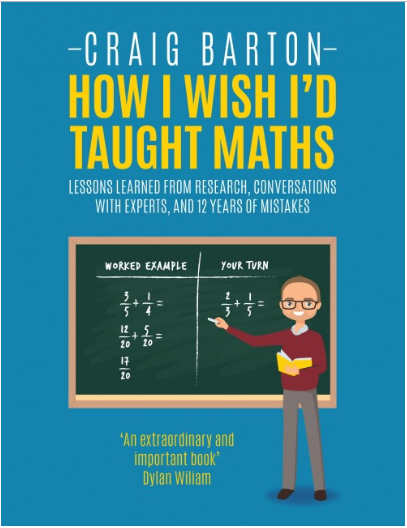Evidence-based education
Do you suppose these beliefs are based on research results? Do you think they have some scientific foundation?
- The best lessons have little teacher-talk and lots of student-talk.
- Where possible, students should ‘discover’ things for themselves.
- We can teach problem-solving.
- Effective differentiation means giving students different work to do.
- The maths we teach should be relevant to our students’ lives.
- Students should always know why they are doing something before they learn how to do it.
- The more feedback we give our students the better.
- Tests are predominantly tools of assessment.
- Doing lots of past papers is the best way to prepare for an exam.
- If students are struggling, then they are learning.
Most of us never challenge or question the beliefs and opinions that we hold so deeply.
Craig Barton, a maths teacher, analyzes these points and many others in his book How I Wish I’d Taught Maths. During his first 13 years as a teacher, Barton had a lot of success as a maths teacher. He taught at dozens of schools, was a mathematics consultant for TES sharing his best practices and resources, and created two extremely popular websites about maths. In addition, his teaching was classified as outstanding in several inspections and his students exceeded expectations on the national exams.
However, he describes all his achievements as a teacher in those early years to illustrate how far you can go without much scientific evidence of what you are doing.
At the end of 2015, Barton had the opportunity to interview several people in the education world. In the interviews, he asked them about details like how they decide what to teach in their classes, what resources they use, and how they evaluate students. All of them had something in common: they were able to justify all of the decisions they made.
Barton realized that, if he had been the interviewee instead of the interviewer, his only argument to justify the decisions he made in class would have been to say it’s obvious. It is obvious that teachers should speak less and hold students accountable for their own learning. That we must teach students to problem solve and allow them to discover things for themselves. For Barton, it was obvious because he had always done it that way. He found that many of the beliefs he had were based on his experience and not on scientific evidence.
Following all these interviews he promised himself that he would read some of the references that his interviewees had mentioned before continuing to prepare his classes. He decided to dive deeper into evidence-based education.
In the introduction of his book, Barton says “The day I started reading educational research was the day my life changed.” The more he read and the more he experienced, the more questions he had. So he kept reading, doing interviews and trying new approaches.
His book, How I Wish I’d Taught Maths is the result of this process.

In upcoming posts, we will be analyzing the 12 chapters of this book, which tell the story of how a successful and experienced teacher completely changed his mind about how to teach mathematics and entered the world of evidence-based education.
Each of the ideas in the book is broken down into four sections:
- What he used to do. He explains his old beliefs, where they came from and what effect they had on the classroom.
- Sources of inspiration. Articles, books, blogs or interviews.
- His takeaways, the conclusions he drew from each of the resources.
- What he does now. In these sections, he describes the new approaches that he is putting into practice in the classroom according to everything he has learned from the references studied.
References:
Barton, Craig. “Introduction.” In How I Wish I’d Taught Maths: Lessons Learned from Research, Conversations with Experts, and 12 Years of Mistakes, 16-23. Melton, Woodbridge: John Catt Educational, 2018.
Learn More:
- Why Are Examples Important When Teaching Mathematics?
- Worked Examples and Metacognition
- The Five Stages of Deliberate Practice
- Cognitive Load Theory and Multimedia Learning
- Motivation – Evidence Based Education







